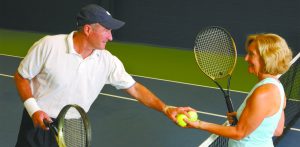 Over the past decade, there has been a dramatic increase in rotator cuff injuries. As we age, our bodies are subjected to more repercussions from normal wear and tear. This is particularly the case with individual’s age 60 and older, but the same wear and tear is accurate for younger people that are very active or have suffered accidental injury through sports or trauma-related causes. Additionally, living in the Sunshine State, permits most adults to be more active year round, which is why there is an uptick in sports related disorders. As more aging individuals are kayaking, playing tennis, golf and pickleball, rotator cuff injuries are growing more common.
Over the past decade, there has been a dramatic increase in rotator cuff injuries. As we age, our bodies are subjected to more repercussions from normal wear and tear. This is particularly the case with individual’s age 60 and older, but the same wear and tear is accurate for younger people that are very active or have suffered accidental injury through sports or trauma-related causes. Additionally, living in the Sunshine State, permits most adults to be more active year round, which is why there is an uptick in sports related disorders. As more aging individuals are kayaking, playing tennis, golf and pickleball, rotator cuff injuries are growing more common.
One of the primary injuries that orthopedic surgeons treat is a rotator cuff tear. The rotator is comprised of four muscles and three main bones. Although there are multiple types of shoulder injuries, rotator cuff injuries cause a great deal of pain when lifting the arm over the head. For people that work in a field requiring lifting, extension of the arms, or big range of- motion, this can be detrimental to their careers. Once the rotator cuff is damaged it can be difficult to wash or style your hair, lift objects or your arm, reach high to get something off of a shelf, pull on a shirt, or put on a hat. If you’re active, your ability to swim, play tennis, golf, or anything requiring maximum arm movement, your activities will be significantly hindered because of the impingement in your shoulder.
Details of Rotator Cuff Tear
The three bones that make up the rotator cuff are the clavicle, humerus and the collarbone. The four muscles create a fulcrum for one main tendon that connects to the upper portion of the humerus bone in the shoulder, this joint allows the shoulder to rotate our arm and shoulder and to move it up, down, and to the right and left. A fluid-filled sac helps to lubricate the rotator cuff.
Over time, wear and tear can cause tiny tears to occur, which can cause discomfort and limit our range of motion. As we age the blood supply in our tendons decreases, this can also cause tears and damage to occur. Extreme shoulder impingement occurs when there is bursa inflammation or bone spurs have sheared off, causing minimal ability to move the shoulder.
Diagnosis and Treatment
Your doctor will diagnose the rotator cuff disorder by a physical examination of your shoulder and your range of motion, along with x-rays, and if needed, an MRI or ultrasound.
Your treatment options are usually to start with an anti-inflammatory medication like NSAIDs, rest and icing the area to take away any of the inflammation. This will allow the rotator cuff to heal itself naturally. If the injury is advanced, or the body will not heal itself due to health or aging-related issues, surgery may be necessary.
Three standard surgical approaches include:
• Open Surgical Repair
• Mini-Open Repair
• Arthroscopic Repair
If the tear is partial, a simple debridement may be all that is necessary, if it is a little more involved, suturing the tendons together and sometimes reattaching the ligaments to the bone may be required. Your orthopedic surgeon will be able to discuss your options in full detail with you during your consultation.
There are traditional surgery and arthroscopic (minimally invasive) surgery options. The good news is if surgery is necessary, it can usually be performed arthroscopically. With Arthroscopic surgery there is no muscle detachment, and through a small incision, the surgeon will have access to the entire shoulder joint. With proper care and maintenance, long-term outcomes are equal to those of traditional surgery. With this minimally invasive technique, your recovery time is traditionally quicker and much less painful.
Your Recovery
• Four to six weeks
• You will need to keep your arm movement to an absolute minimum during this time
• Sling to restrict your movements
• Physical therapy to get you back to a full range of motion; this is especially true if your job or sports activities require a lot of arm and shoulder rotating or lifting
To find out more rotator cuff tears, or your other orthopedic needs, please call Advanced Orthopedic Institute at (352) 751-2862
(352) 751-2862
1400 N US HIGHWAY 441
SHARON MORSE MEDICAL OFFICE BUILDING, SUITE 552
THE VILLAGES, FL 32159-8975
Check Also
CUSTOMIZABLE LIGHT ADJUSTABLE LENS A GAMECHANGER FOR CATARACTS PATIENTS
All Americans have some degree of cataract change by the age of 75. As the …
 Central Florida Health and Wellness Magazine Health and Wellness Articles of the Villages
Central Florida Health and Wellness Magazine Health and Wellness Articles of the Villages



